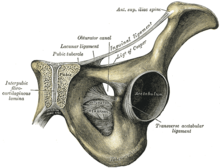Pubic symphysis
The symphysis pubis ( pubic symphysis ) is the point at which the right and left pelvis , more precisely the pubic bones of both sides are connected to the front. In quadruped mammals , the pubic symphysis forms only part of the connection between the two halves of the pelvis. Here the ischium is also involved in the form of a sciatic symphysis . Both parts together are called the pelvic symphysis ( symphysis pelvina ). In all mammals, the two halves of the pelvis are connected by fiber cartilage (symphysis).
Clinical significance
In humans, there is a disc ( discus interpubicus ) between the bony parts , which keeps the connection flexible. This is very important in childbirth . During pregnancy, this fiber-cartilage connection becomes more flexible under hormonal control . In an estimated one in 600 pregnant women, this loosening is too strong and a so-called symphysis loosening occurs , which is very painful. During delivery, the symphysis can be overstretched (symphysis dehiscence) or even tear ( symphysis rupture , symphysis rupture ), which also leads to severe pain.
It is not yet known which treatment is the most effective. Training of the pelvic stabilizing muscles , water aerobics and trochanter belts have proven effective .
A surgeon can also help if conservative medicine is not helpful. A stiffening of the joint by means of one / two metal plate (s) and a few screws, possibly with the help of your own bone chip from the iliac crest, can restore stability and at least largely alleviate the discomfort, possibly even completely recover.
The straight abdominal muscles ( rectus abdominis muscle ) attach to the pubic bones .
